In your office or any workplace, you must have seen fire extinguishers placed in distinct identifiable locations. It is a mandatory safety requirement to keep fire extinguishers in places where there are possibilities of fire hazards. But most of us do not know many details about this widely used fire protection device. In this article, we will explore more details about fire extinguishers, their types, selection, and inspection requirements.
Fire Extinguisher Meaning
A fire extinguisher is an active fire protection device for controlling or extinguishing small accidental fires. During emergency situations, a fire extinguisher can control a small fire. However, these devices should not be used for out-of-control fire events that endanger the user. Usually, a fire extinguisher consists of a cylindrical pressure vessel containing an agent that has the capability to extinguish a fire when discharged. A person can easily operate this device. Non-cylindrical Fire extinguishers are also available but are less common.
Fire Extinguisher Parts
Usually, most fire extinguishers consist of similar parts and components even though the extinguishing agent may differ. Common fire extinguisher parts are:
- a cylindrical tank containing propellant and an extinguishing agent.
- a release system comprised of a squeeze handle, a valve assembly, and a release lever.
- a safety mechanism comprised of a tamper seal and a pull pin.
- a hose for directing the extinguishing agent.
The following figure (Fig. 1) shows the typical fire extinguisher parts:
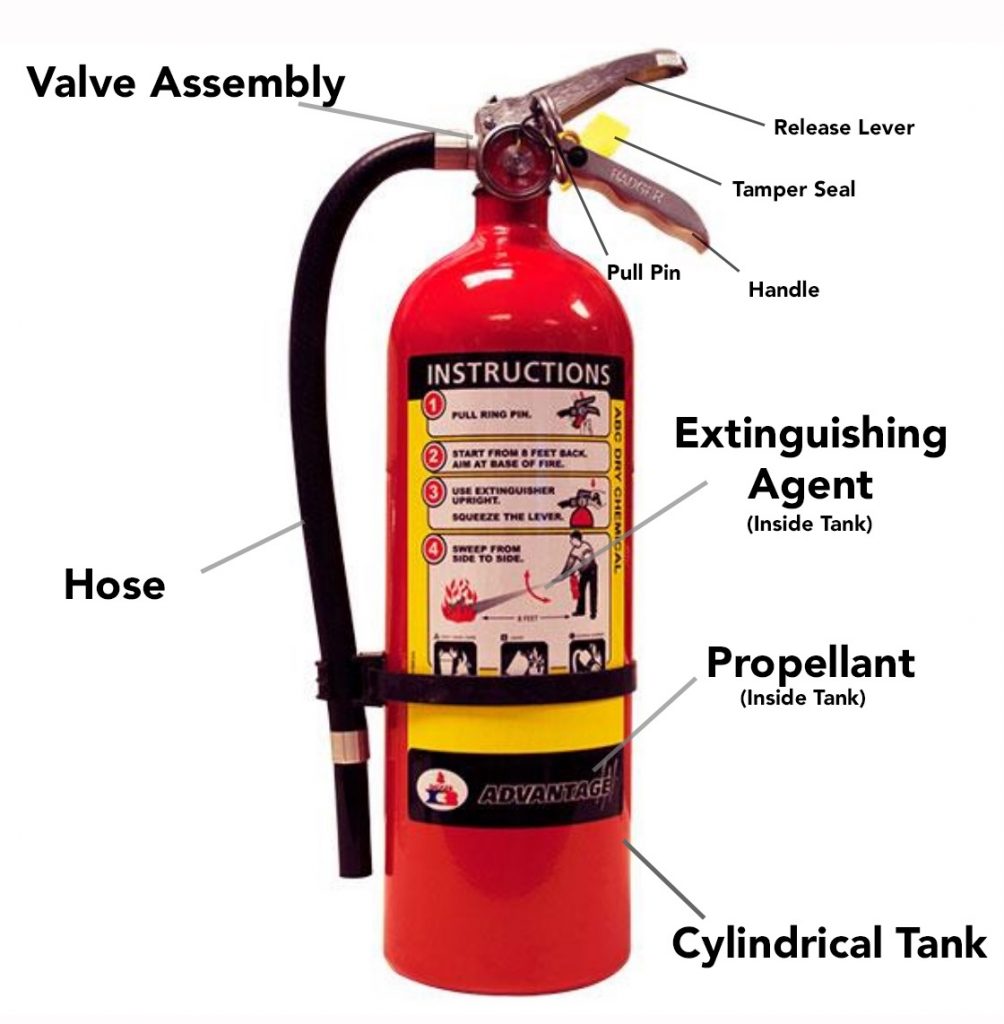
Classes of Fire Extinguisher
Depending on the specific fire types, fire extinguishers are also classified into six groups as listed below:
Class A fire extinguisher: These fire extinguishers are used to put out class A fires characterized by fire from ordinary solid or dust combustibles like wood, paper, textile, plastic, fabric, cardboard, etc.
Class B fire extinguishers: Class B fire extinguishers are used to prevent Class B fire hazards from flammable liquids like grease, gasoline, oil (except cooking oil), paint, etc.
Class C fire extinguisher: Class C fires originating from flammable gases like methane, butane, propane, hydrogen, etc are best handled using class C fire extinguishers.
Class D fire extinguisher: Class D fire extinguishers are widely used to put out fires generated from combustible metals, such as magnesium, sodium, potassium, lithium, titanium, or aluminum.
Class E fire extinguisher: These fire extinguishers are used to extinguish fires that originated from live electrical sources. However, in many countries, this is not recognized as a separate fire class because once the electric power supply is switched off it can be considered as any of the other five classes.
Class F fire extinguisher: Class F fire extinguishers find their use to extinguish class F fires characterized by fires from cooking oils, vegetable oils, fats, butter, etc.
Note that, the above fire extinguisher classes slightly vary from country to country. The comparison is tabulated below for guidance:
| American | European | UK | Australian/Asian | Fuel/heat source |
| Class A | Class A | Class A | Class A | Ordinary combustibles |
| Class B | Class B | Class B | Class B | Flammable liquids |
| Class B | Class C | Class C | Class C | Flammable gases |
| Class C | Unclassified | Unclassified | Class E | Electrical equipment |
| Class D | Class D | Class D | Class D | Combustible metals |
| Class K | Class F | Class F | Class F | Cooking oil or fat |
Types of Fire Extinguishers
Based on the content inside the vessel, 6 main types of fire extinguishers are available. They are:
- Water fire extinguishers
- Foam fire extinguishers
- Powder fire extinguishers
- Carbon dioxide (CO2) fire extinguishers
- Wet chemical fire extinguishers
- Clean agent fire extinguishers.
Water Fire Extinguishers:
Water fire extinguishers are the most economic and simplest among all fire extinguisher types. They are suitable to put off class A fires. All water extinguishers have a bright red label. Water fire extinguishers are widely used in shops, domestic buildings, offices, retail premises, schools, hotels, warehouses, hospitals, etc. Water fire extinguishers are of four types:
- Water jet extinguishers
- Water spray extinguishers
- Water extinguishers with additives, and
- Water mist extinguishers
A water jet extinguisher throws a water jet at the burning material forcing the material to cool down and preventing re-ignition. Water spray fire extinguishers use a very fine spray of water droplets surrounded by air to extinguish the fire.
A foaming chemical is added to the water fire extinguishers with additives that help in effective soaking into the burning materials. The addition of chemicals can cause a smaller fire extinguisher to produce the same fire-fighting capability as a larger, water-only, fire extinguisher.
Water mist fire extinguishers apply water in the form of fog or mist. The generated mist droplets are much smaller as compared to those formed in the water spray fire extinguisher. Smaller droplets possess larger surface areas in relation to their size. Such smaller droplets evaporate quickly absorbing the heat energy from the fire.
Foam Fire Extinguishers:
Foam fire extinguishers find their application to put out class A and class B fires. They blanket the fire with a foam generated when the spray hits the air. This blanket prevents the vapors from reaching the air. Also, the water in the foam provides a cooling effect to prevent re-ignition. Foam fire extinguishers carry a cream label.
Powder Fire Extinguishers:
Powder fire extinguishers are multi-purpose extinguishers with numerous advantages. It is one of the most common extinguishers in wide use as powder extinguishers can be effectively used on Class A, B, C, and E fires. Fine chemicals in powder form as extinguishing agents are released by the powder extinguishers to blanket the fire and suffocate it. The common powder is mono-ammonium phosphate.
However, as they do not cool the fire, there is a possibility of re-ignition. Also, powders can create a loss of visibility and breathing problems. So, powder extinguishers should be used as the last resort. Powder fire extinguishers carry a blue label.
Carbon Di-Oxide Fire Extinguishers:
A carbon dioxide fire extinguisher (CO2) is ideal for fires involving electrical hazards (Class E). This is one of the cleanest types of fire extinguishers in commercial use and requires no clean-up after use. CO2 fire extinguishers can also be used on class B fires involving flammable liquids.
Carbon dioxide fire extinguishers blanket the fire by cutting off the air supply which in turn removes oxygen, required for the fire to continue. CO2 fire extinguishers carry a black label.
Wet Chemical Fire Extinguishers:
Wet chemical extinguishers are highly efficient extinguishers and ideal for fire hazards involving cooking oils and vegetable fats (Type F or type K fire class). They contain a potassium solution that rapidly knocks the flames out, cools the hot oil, and seals the liquid surface with a thick soap-like substance generated by a chemical reaction. This soap-like substance prevents re-ignition. Wet chemical fire extinguishers can also be used for class A fires and they carry a yellow label.
Clean Agent Fire Extinguishers:
A clean agent fire extinguisher is a gaseous fire suppression system. The agent in its liquid phase is stored in the cylinder. When it is sprayed through the nozzle, the clean agent converts into a non-conductive, safe eco-friendly gas upon contact with the air. The gas extinguishes the fire by reducing the oxygen levels and impeding the chain reaction. They are ideal and widely used for class B and E-type fires.
The following image in Fig. 2 provides a quick reference fire extinguisher type chart:
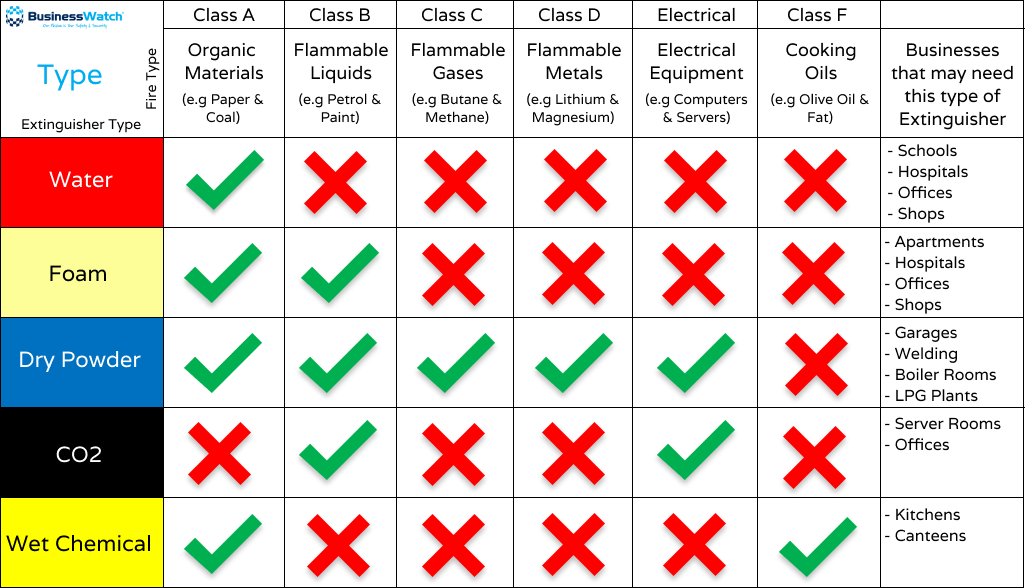
Automatic fire extinguishers
Automatic fire extinguishers are used to fight transport fires (engine compartments of boats or large vehicles, or in industrial use, such as in generator or computer rooms). They are automatic, and easy to recharge. Once they detect heat, Automatic fire extinguishers immediately act. They are suitable for Class A, B, C, and electrical fires and contain dry powder or clean inert gases as the extinguishing agent.
Selection of Fire Extinguisher
To select a fire extinguisher, one needs to identify the fire class. Knowing the reason or origin of the fire hazard can be helpful in determining the fire class. The chart in Fig. 2 will be helpful in deciding a specific fire extinguisher type selection. If the fire hazard contains a mix of fire classes, it is important to select an extinguisher that can control all of the hazards present. The manufacturers provide the rating for the extinguisher and that is specified on the product label affixed to the extinguisher. The main factors that should be considered while selecting a fire extinguisher are:
- Fire Extinguishers of certain fire hazard types may not be effective against fires of a different hazard class. Even, it may increase the fire severity if not selected carefully.
- Extinguishers intended for certain types of hazards can increase personnel hazards for users when used against different hazard-class fires.
- Extinguishers rated for multiple fire hazards may have different levels of effectiveness for each hazard.
- Fires involving metals are controlled by class D extinguishers. Note that, an extinguisher that may be highly effective in one type of metal fire, may be dangerous in other types of metallic fires.
- Class F (K) fire extinguishers for controlling kitchen fire exposures may not be suitable for conventional usage.
How to Use a Fire Extinguisher
It is the responsibility of the employer to educate designated employees on how to use a fire extinguisher during emergency situations. It is part of a mandatory emergency fire evacuation plan. The specified person must know the locations and the types of extinguishers in the workplace.
As fire extinguishers are usually heavy, frequent practice of picking up and holding the extinguisher is advantageous. Also, the user must read the operating instructions and warnings mentioned on the fire extinguisher label.
Now to use a fire extinguisher, a simple technique known as the PASS fire extinguisher technique is used. This is a four-step method as described below:
- Pull: Pull the pin to break the tamper seal.
- Aim: Aim the nozzle or hose at the base of the fire from the recommended safe distance. For CO2 fire extinguishers, care must be exercised not to touch the horn as the severe cold can damage the skin.
- Squeeze: Squeeze the handle or operating lever to release the fire extinguishing agent.
- Sweep: Sweep the nozzle from side to side at the base of the fire until the fire appears to be out. If fire re-ignites steps from 2 to 4 should be repeated.
Using this PASS fire extinguishing methodology, small fires can easily be prevented. But remember to evacuate immediately in case of the slightest doubt regarding the capability to fight a fire.
Fire Extinguisher Inspection
NFPA 10 provides the guidelines for Fire Extinguisher Inspection Requirements to ensure the extinguisher works fine during fire events. Usually, a fire extinguisher inspection is conducted monthly by safety officers or external professionals. The inspection of fire extinguishers consists of the following steps:
- Check Accessibility: Ensure that the fire extinguishers are available at the designated accessible places and clearly visible and unobstructed.
- Examine the Physical State: Thoroughly examine the extinguisher for any physical damage, clogged nozzle, corrosion, leakage, etc. The locking pin should be intact and the tamper seal unbroken. The fire extinguisher operating instructions should be clearly visible.
- Inspect the Pressure Gauge and Weight of the extinguisher: Ensure that the dial indicator of the pressure gauge is in the operable range. Also, ensure that the fire extinguisher is full by weighing or lifting the device. For wheeled fire extinguishers, confirm the condition of tires, wheels, carriage, and hose, and that the nozzle is good for working.
- Check the inspection tag: The inspection tag should be filled to ensure that the fire extinguisher is regularly inspected.
- Recommended action and closeout report: Any observation should be informed to the concerned person for necessary action and a report must be prepared indicating the date of inspection. Such fire extinguisher inspection reports must be maintained for at least 12 months.
Depending on the type of extinguisher, an internal examination of fire extinguishers must be conducted within 1-6 year intervals.
Online Classes for Fire Safety
If you wish to know more and enhance your knowledge of Fire safety, you can join any of the below-mentioned online classes. To start the course click on the subject of your interest, read the complete details, and then enroll in the class:




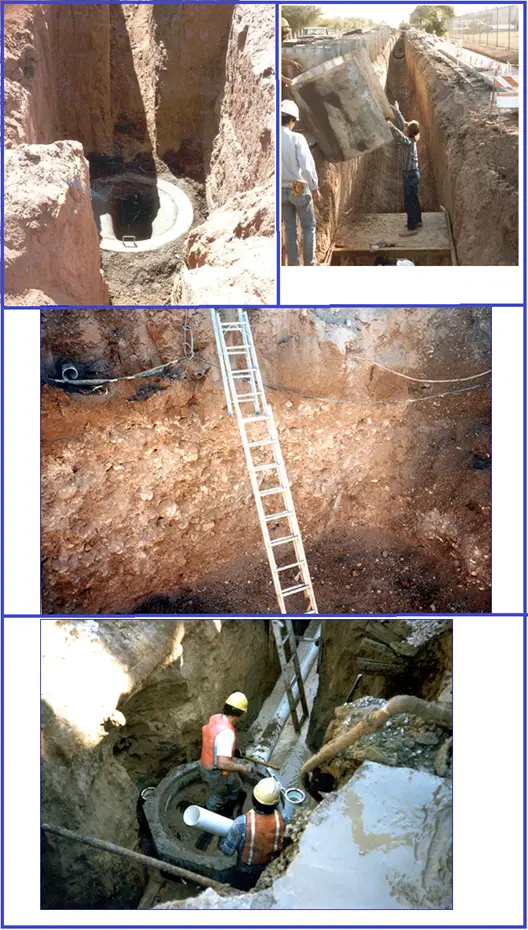


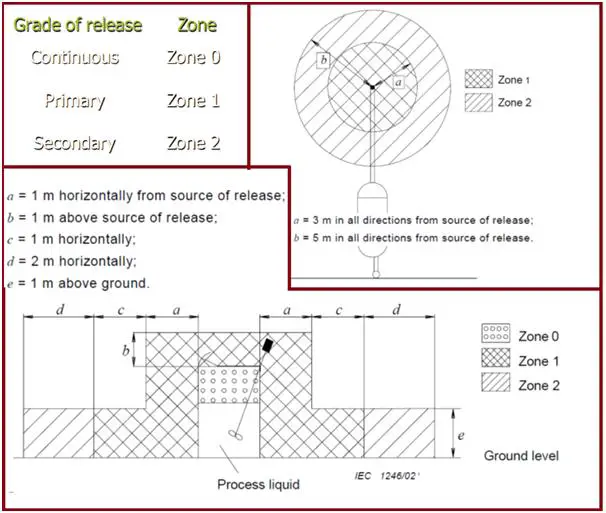
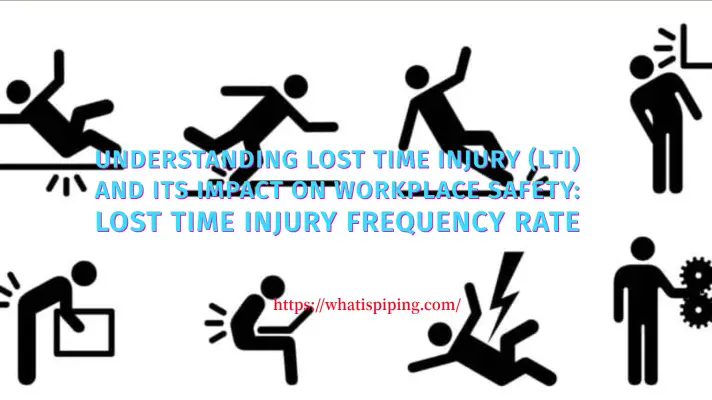
It’s quite intimidating to know that there are several methods that fire extinguishers can be used. These models really do sound a lot easier to use if you have an idea on how they operate, which is crucial in times like a fire risk. Should I ever start a business of my own, I’ll make sure we know of a fire extinguisher training class for the employees.